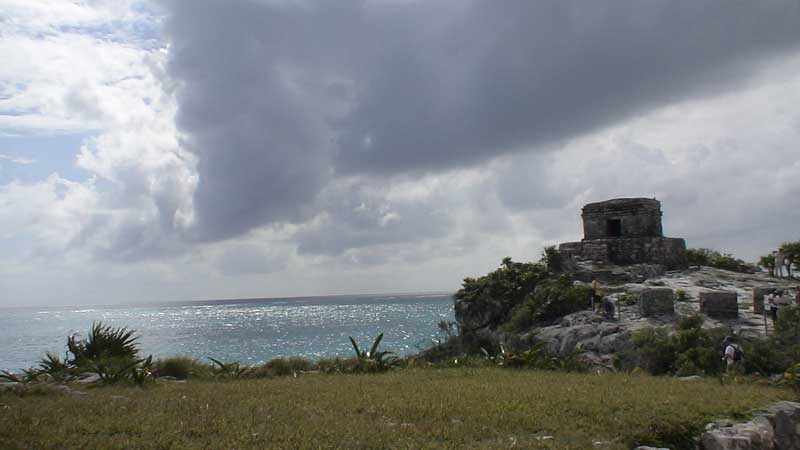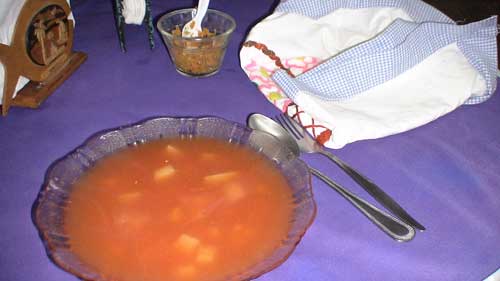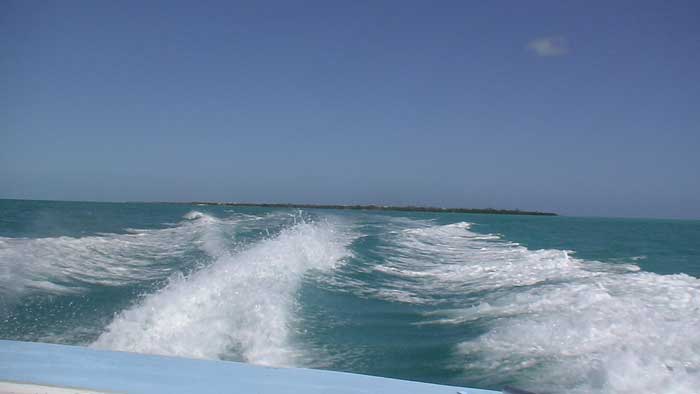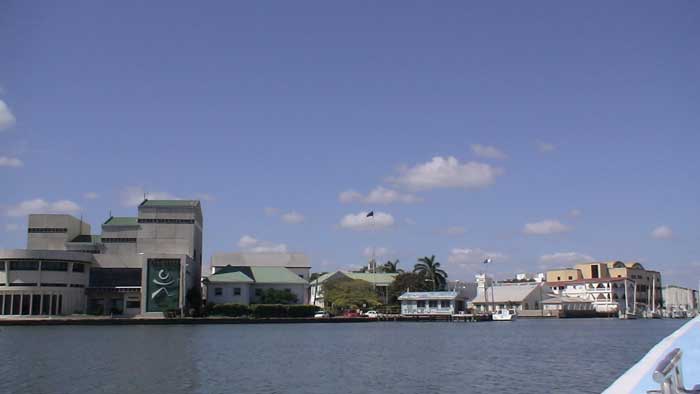
| Previous Page . . . | Continue to Part 3. . . |
 |
| Tulum in Quintana Roo, Mexico. Admire the ruins, then walk a few steps and jump right into the Carribean Ocean. |
 |
| Potato soup with salsa picante and corn tortillas. The tender potatoes and tomato broth tasted like something my mother might make. I ate this meal at Vegetariano La Fuente in Chetumal before crossing the border to Belize, and was grateful for the service. |
 |
| The famous blue waters of the Caribbean Ocean. Here we are traveling back to Belize City from Caye Caulker. Caye Caulker is well known for diving and snorkeling and offers a laid back small island experience. |
 |
| A photo of Belize City coming into the harbor. Nothing much to note other than the performing arts center to the left. The harbor is probably one of the nicer things about Belize City. |
We wanted to be in Tulum that night to sleep at Uno, owned by Nuna, one of Nacho’s friends. So in a few hours, I met the tranquil Nuna in his beach camping resort. There are number of beach strips broken up by rocky outcroppings in Tulum. I walked the length of the beach, alone and at peace. There were only a few tourists around and they greeted me in English. It was dark by the time I returned and I couldn’t find Uno, our camping ground. Finally, by asking someone I found my way and saw Nacho sleeping on a stone wall. For dinner we ate Italian salads at La Nave in the town. The night at Uno’s, a beautiful music group called Mirabai played songs with harps, flutes, tablas and guitars. The music continued for hours and was quite original and soothing. The artists were a mix of different cultures and backgrounds, and their music had Middle Eastern, Indian and Celtic influences. In the room where we listened Nuna, who was from Portugal, had placed pictures of Swami Nityananda and Mirabai. The next morning Nacho admitted that he wasn’t feeling well. He also wanted to return to Mani for a social event at the Mayan school he was studying and to see the Zapatistas. I had grown quite dependent on Nacho and knew I would miss him on the rest of my journey. “Get a grip man, you’re in Tulum. People pay a lot of money to be here,” said Nacho. So without any long goodbyes, we parted ways with the plans of meeting again sometime soon. I thought it would be too lonely to stay in Uno’s another night, so I decided to leave. I quickly visited the ruins at Tulum which are right along the turquoise waters of the beach. Tourist groups create pockets of noise and clog the winding paths of this former port city of the Mayas. Nacho had told me a lot about Belize and I wanted to make a detour there before heading to Guatemala. Chetumal, a border town, has numerous buses to Belize City that last for about 8 hours. I spent the night there at a hotel, also named Maria Dolores, and left the next morning for Belize City. I did not get a stamp or arrival card when I crossed the border from San Ysidro to Mexico. No one had checked my papers at all. This may have caused problems on the entry into Belize. I asked the bus conductor about my lack of a departure card, and he told me to just get back on the bus. I crossed the border without having to go through Mexican immigration. Nacho had slept in the cemetery when he was in Belize City, but I shacked up at the Seaside Guest House. The service was decent and breakfast is included. I explored the city the next morning and was amazed at how different it was compared to Mexico and probably the other Central American countries. East Indian and Chinese people own many shops and businesses. The population is predominately Creole, a mixture of African and Caucasian ancestry, but there are also Mestizo, Mayan and Garifuna. The people speak English but with a Caribbean accent, many phrases and aphorisms are unfamiliar. Most of the houses are built clap board style with thin walls and roofs. Windows and doors are usually fortified by iron bars. Families sell grilled chicken with rice and beans on street corners playing rap or reggae music on the stereo. Young men wearing sleeveless undershirts or “wife beaters” roam the streets on bicycles. You can feel a little harassed in the city if you look like a tourist, but most people are welcoming. Many locals admit that they won’t go out after dark, so everything closes early. A Garifuna named Gary accosted me and tried to sell me his music CD. He turned out be a friendly guide to the city for a short while. We visited the Baron Bliss Tomb and I walked by the swing bridge to purchase my ticket to Caye Caulker. Ambergris Caye is the largest of the islands, but some people told me that Caye Caulker is the place to go for a relaxed vibe. Be sure to visit the water taxi terminal for a cheaper roundtrip fare to the island for $25. Caye Caulker is so small that it can be walked in an hour or so and golf carts are used for faster transport. I spent my time walking the island and chatting up with the shop vendors and a few of the travelers I had met on the boat. I quickly got bored, mostly because there didn't seem much to do except loaf on the beach. Even the swimming spots were limited. There is only one decent place to swim called the split. But I am sure many people would dig the tropical island culture. The best thing to do is go snorkeling or diving. If you have the time, training or money you can experience the Blue Hole or the Corral Reefs. Belize is said to have some of the best diving in the world. I had plenty of time to spend staring at the Caribbean blue ocean, glazed and shining with sunlight. I met many Americans, especially from Texas, the southern drawl leaking into conversations when I lingered in hotel lobbies or restaurants. Some Americans had come out to Belize to do missionary or building work. From Caye Caulker, I traveled back to Belize City and immediately found a bus to San Ignacio which is the border town to Guatemala. The bus ride was a few hours. At the ATM machine in town, I ran into Amit from Boston. We proceeded to have lunch at the new South Indian restaurant, run by George from Kerala. Served in a homely style, the appams were just average but it was an interesting diversion. Amit and I discussed various topics such as the Unabomber, leisure vs. work, education and CPR certification. He had come to Belize to study pottery at Placencia, a palm lined beach in the south of Belize. He told me about his experience sleeping under a hammock, catching fish to eat and interacting with the locals. In the town, he introduced me to a massage therapist named Sharane. Inside her massage parlor I saw pictures of Sai Baba and I arranged to speak with her more and have a massage. I enjoyed the easy going atmosphere of San Ignacio compared to the kinetics and everywhere-you-look-a-spectacle of Belize City. I stayed two nights at the Tropicool for about $11 a night. I was only regretful that Sharane could not make our appointment for a massage, and Amit had to leave the next day. Buses and taxis depart regularly for the border from the town. Once you pay the hefty departure tax of $19 to exit Belize, you can cross into Guatemala and from there find transportation to wherever you desire. |
Movie Clip
Please press play
| Tulum, Caribbean |
| Continue to Part 3 . . . |